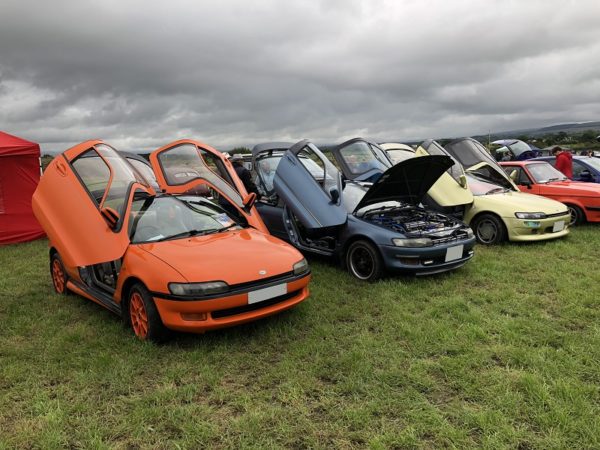
The Toyota Sera is a rare sight in Britain. Made only for the Japanese market, the Sera (model designation EXY10) was a 3-door 2+2 hatchback coupé produced from 1990 to 1996. It was launched in 1988 as the Toyota AXV-II concept car in a form very nearly ready for production. It was especially noted for its extensive glass roof and its butterfly doors, which tilt up and forward when open.
Toyota marketed three trim versions, known as Phases, in marketing channels kept separate from those used to sell the MR2. 15,941 examples were built between February 1990 and December 1995, with almost all of those being registered in Japan.
The Sera was powered by the 1,496 cc inline 4-cylinder engine also used in the Paseo and the Starlet. It produced 104 bhp and 97 lb⋅ft of torque. This was installed in a front-mounted front-wheel drive transverse configuration with electronic fuel injection. Mechanically the car was related to both the Paseo and the Starlet, sharing similar floorpans, suspension, steering and brakes.
The most dramatic feature of the Sera is undoubtedly the design of its doors. These are hinged at the top and bottom of the A pillar and open forward and up in a similar manner to those of the 1992 McLaren F1 and the 2000 Saleen S7. Gordon Murray, the designer of the F1, cited the Sera as the inspiration for the F1’s door arrangement. Unlike conventional hinged side-opening doors, these butterfly doors can be opened fully in a fairly confined space.
The rear hatch was constructed from a single piece of glass without a supporting steel frame. This, in combination with the remaining large glass windows and roof panels gave it a distinctive look and superb visibility. The downside, a susceptibility to overheating in sunny weather, was countered by air-conditioning and twin removable interior roof panels.
There were many factory options – but the most sought-after of these was an advanced car audio system known as the Super Live Surround Sound or SLSS. This comprised a total of 10 speakers, a three-mode Digital Sound Processor (DSP) which cycled through ‘off’, ‘Casual’ or ‘Funky’ mode by use of a button labelled “WARP”. A complete and functional SLSS is one of the options most highly prized by Toyota Sera enthusiasts.
Sera buyers could also add one of two electronic air cleanser/fresheners: the roof-mounted “CleanAce” or an integrated device known as an “Air Fantasy” that was mounted in the centre console This would pump small bursts of scented air (from one of three replaceable scent packs) either automatically or on demand through the air vents. The Air Fantasy is especially rare.
This is an unusual car but one that certainly arouses passions in those in the know. These three examples were seen together at a vintage air fair and stole the show.







The term phases in regards the Sera was applied by me. Toyota had a minor update – a few mechanical changes and some different seat fabric in May 1991 and then another very minor update in June 1992 and I used the term phase to refer to which phase of production a particular car belonged to.
Deliveries began in March 1990 and production ceased in December 1995. Pre-production started in the latter half of 1989 with pre-production cars on the road by December 1989 – road testing, durability testing, and press/publicity, but it wasn’t until February 1990 that production began in earnest so that deliveries to begin in March.
At the moment there are around 90 examples in the UK that are currently taxed and MoT’d. In 2007, the Society of Motor Manufacturers and Traders told me that there were 328 cars with valid VED and 174 with lapsed VED. Asking again at the end of 2015, those numbers had dropped to 177 and 104.
A number have been exported out of the UK – to Europe or the US, and many others have been scrapped, either as part of scrappage schemes or people who see more value in the parts than the current market value of the car